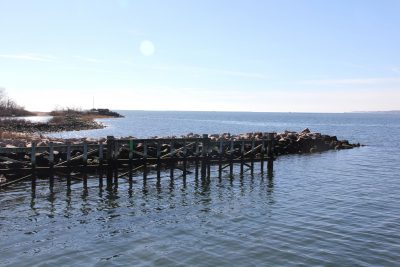
Six research projects relevant to Long Island Sound and continuing improvements in its restoration and management have been selected by Connecticut Sea Grant for the 2024-2026 funding cycle.
The projects recommended for funding would receive nearly $900,000 in federal grant funds that would be leveraged by about $458,000 in matching funds, for a total research investment of more than $1.35 million. Release of the funding is pending final approval from the National Oceanic and Atmospheric Administration.
The researchers, from the University of Connecticut, Yale University and partner organizations, will focus on: assessing salt marsh restoration sites; interactions between eel grass and oyster aquaculture; natural transport of oyster larvae; pathways and prevention of plastic marine debris; the diets of black sea bass; and approaches to overcoming barriers to underrepresented minorities entering the environmental workforce. The research would be conducted over the next two years.
“These research projects span natural to social sciences, address environmental issues relevant to human activities such as aquaculture, fisheries, salt marsh restoration and marine debris, and explore diversity and equity issues related to environmental workforce development,” said Sylvain De Guise, director for Connecticut Sea Grant. “Together, they reflect the diversity of Sea Grant interests and approaches to contribute new knowledge on relevant and important environmental issues.”
The projects are:
- “Leveraging sediment addition experiments across the Long Island Sound to examine medium-term ecosystem responses,” led by UConn Associate Professor Beth Lawrence, and co-led by UConn colleagues Ashley Helton, Chris Elphick and Connecticut Department of Energy and Environmental Protection Research Scientist Min Huang. The project will assess 170 experimental plots in four tidal marshes situated along the Connecticut coast which have received sediment additions to help maintain them in the face of rising sea levels. The plots will be measured to determine changes in plant biomass and greenhouse gas exchange. The resulting information will be used to inform coastal management and promote more resilient coastlines.
- “Oyster aquaculture associated with eelgrass habitat—maybe we can get along after all,” led by UConn Professor Craig Tobias and co-led with Jamie Vaudrey, research coordinator of the Connecticut National Estuarine Research Reserve. The researchers will grow oysters in submerged cages within eelgrass beds to assess the impact of this activity on the growth of the eelgrass and shellfish. They hope to demonstrate that restoration of eelgrass beds, which provides critical habitat for marine life in the Sound, can occur in tandem with oyster aquaculture, which improves water quality in the estuary.
- “Quantifying larval connectivity patterns and variability among natural oyster beds along the Connecticut coast,” led by UConn professors Michael Whitney and Catherine Matassa. The researchers plan to create a model showing how oyster larvae travel from spawning areas in the Housatonic River to natural shellfish beds in the Sound near Bridgeport and Stratford, which are important sources of seed oysters for commercial shellfish farmers. The project will also assess larval transport to other beds offshore from Milford, Bridgeport-Fairfield, Norwalk and Greenwich, and examine factors which influence year-to-year variability in the pathways. The results will be shared with regulators, managers, educators and other researchers.
- “Understanding the urban plastic litter cycle to optimize management and prevent export of marine debris,” led by Yale University Professor Gaboury Benoit in partnership with the Mill River Watershed Association in New Haven, supports goals of the Marine Debris Action Plan for Long Island Sound. The project will document the life cycle of litter, identifying all the places where plastic litter accumulates in the watershed, which flows directly into the Sound. The researchers will track how rapidly the litter moves and is degraded along the way, characterizing the kinds of plastic and their sources. The information will be used to determine the most efficient way to manage plastic litter and reduce the amount entering the estuary.
- “A first comprehensive evaluation of black sea bass diets in Long Island Sound,” led by UConn Associate Professor Hannes Baumann, and co-led with UConn colleagues Catherine Matassa and Paola Batta-Lona, and Kurt Gottschall of CT DEEP, will analyze the stomach contents of a fish population that is expanding rapidly in the Sound with warming water temperatures. The researchers plan to collect samples from 700 black sea bass caught in CT DEEP trawl surveys, and 300 from recreational fishermen on the Black Hawk charter boat in Niantic. The results will be used to assess the impact of growing numbers of black sea bass on food webs in the Sound and elsewhere in New England and shared with state and regional fisheries managers.
- “Barriers to career pursuits of high school (including Upward Bound) students in the environmental workforce” led by UConn Associate Professor Anita Morzillo in collaboration with Laura Cisneros, assistant extension professor at UConn. This project seeks to understand challenges faced by high school students in pursuing careers in the natural sciences. To do so, the researchers will provide watershed science lessons, activities and interactions with environmental professionals to more than 200 students in three college experience programs, then survey them about their motivations, obstacles, inspirations, pivotal events and other factors that influence their decisions about environmental careers. The findings will be used to develop strategies to strengthen the emerging natural resource focused workforce.
“The six strong research proposals are all directed at creating outcomes and insights that will help resolve some of the tough issues facing our state as we work on creating a healthy Long Island Sound and vibrant and resilient coastal and watershed communities,” said Syma Ebbin, research coordinator.
The CTSG research funding competition is open biennially and utilizes federal funding administered by Connecticut Sea Grant to support projects that improve the health of marine and coastal ecosystems and benefit the public. Connecticut Sea Grant is a partnership of UConn and the National Oceanic and Atmospheric Administration, one of 34 Sea Grant programs across the country. It is based at UConn’s Avery Point campus in Groton.